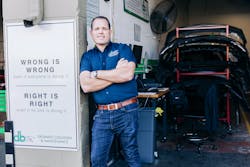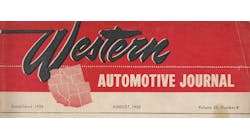SHOP STATS: DB Orlando Collision Location: Orlando, Fla. Owner: Drew Bryant Staff Size: 16 Average Monthly Car Count: 60 ARO: $3600 Annual Revenue: $2.6 million
Owning a collision repair shop was never really on Drew Bryant’s radar. While he “dabbled” with cars, tinkering with custom audio equipment as a side job, he spent nearly all of his time devoted to his full-time job as a regional training manager for Panera Bread (where he often pulled 70-hour workweeks).
But after getting in an accident and having a bad experience at a shop that repaired his vehicle improperly, Bryant realized there could be an opportunity to combine passion and expertise in his next move.
Motivated by the central principle of providing a complete and correct repair, Bryant set out to learn everything he could about the industry.
“The more I dug, the more it fed the hunger to learn more and get into the industry,” Bryant says.
Coming from the restaurant industry where Bryant was tasked with making sure two locations six hours apart provided an identical product, he was deeply ingrained in process-based operations. That influenced him heavily when he opened DB Orlando Collision in 2011.
And that approach, combined with Bryant’s work ethic and passion for his employees, has pushed the staff of 17 to produce nearly $3 million in annual revenue and be named one of FenderBender’s 2022 Best Workplaces.
Freedom Through Processes
DB Orlando Collision is about as process-based a shop as you’ll find. Everyone knows what is expected of them because it is explicitly stated due to the implementation of 5S and lean principles. There are lines on the floor delineating workflow; pictures around the shop indicate where everything is located; extensive digital checklists have been created for every department; there are large signs on the walls that show the requirements for every department; and job descriptions and orientation procedures are written for every new employee, including details as small as how to open and close the shop.
“My background was getting a roast beef sandwich to be consistently made from eight shops hours from each other. I just applied that to a body shop environment,” Bryant says.
While it may sound rigid, the goal is to make everything as clear as possible to the employees. Expectations are clearly outlined and employees understand what they need to do to be successful.
And while the processes and expectations are straightforward, it doesn’t feel restrictive, parts manager Jack Wallace says.
“It feels good, at the end of the day, because you’re accomplishing what we’re expected to accomplish,” Wallace says. “For me, it’s freeing because it keeps me on point.”
It also keeps the employees accountable to each other, which has created a positive working environment, Abe Alghannam says, one of the shop’s painters.
“It’s a whole different ballgame over here,” Alghannam says, comparing it to shops he’s worked at in the past. “Everyone feels like a family. The leadership rubs off and it’s effortless now. We all care about each other, joke around.”
Training a Must
Unsurprisingly, the shop also has a very thorough apprenticeship program. Bryant established the program after seeing that local schools in his area, though they had proper funding, lacked the training repair education. By working with the schools and visiting them personally, he established relationships that led to a pipeline for his apprenticeship program. Now they take on two apprentices per year, who are supplied with tools, which they are allowed to keep after a year, and are trained by Bryant and his staff. Several of those apprentices have stayed on full-time. Bryant says the experience has been valuable for his own team because they always end up learning from the students as well.
The apprenticeship program is part of a philosophy of promoting from within. More than 50 percent of employees have moved up through the company. Wallace, who started with no industry experience eight years ago, is one. He maneuvered his way throughout the shop, learning nearly every job but structural and paint, and is now the parts manager.
“There’s always a chance for training and learning new aspects of the industry, which I love,” says Wallace, adding he takes advantage of the I-CAR and ATI training that the shop provides for the employees.
It’s part of the reason Wallace has never thought about leaving and “will stay here for as long as they have me.”
Bryant’s Leadership Tips
—
- Creating a Culture of Leadership: “It's about establishing a culture of collaboration and execution. You must align your leadership skills with your teams' incentives so that your team members all pull in the same direction and remain engaged in the process… The key to holding your team members accountable while implementing this mindset is continually looking upstream to determine what could have been done differently. What can be tweaked or updated to improve the outcome or obtain the most predictable result?”
- Set Production Standards and Monitor Performance: “Each team member's efficiency should only be judged against clear, measurable, relevant and most importantly, attainable metrics that coincide hand in hand with the needs of your overall operation. The admin team develops the targets/goals for the month, week, etc. Then the production manager is held responsible for spoon-feeding the daily production targets throughout the week, ultimately fulfilling the administration team's promises to each other. The original projection is formulated during a disciplined specific meeting held weekly. To ensure maximum accountability to projections, all parties responsible for any variables impacting deliveries such as parts, payments, approvals, or customer availability are present and held accountable for providing feedback while mutually producing a realistic projected sales target.”
- First impressions & Personality-driven Communication: “Many of us underestimate our facility's first impression while onboarding new team members. The truth is, they are just as crucial, if not more important, than the first impression you would make on a potential client. We have spent a significant amount of energy on department-specific written employee onboardings & orientation scripts. These include specifics related to the onboarding of any new team member, such as the responsibilities of our administration team, defined facility tours, workspace introductions, job description introduction, department-specific daily in-process checklist requirements, department-specific daily closing checklist requirements, preventive maintenance responsibilities, etc. Everyone's role within your facility must be communicated with clarity and be specific to why they are an integral part of your operation. To ensure your team members are executing at their prime, you must ensure this message hits home.”
From the Top Down
Among the main motivators for employees, Alghannam says, is the amount of effort Bryant puts in himself. He isn’t an absentee owner, or someone who is back in his office keeping to himself.
“He comes in every day and works harder than anyone here. Every day we go home and we’re like, ‘Dang, how did he do that?’,” Alghannam says, calling Bryant’s leadership “untouchable.”
For Bryant, that’s all he’s known, from working long hours in the restaurant industry to starting his own business. However, he’s also the first to pester Alghannam to go home at night and stop coming in on the weekends.
Bryant’s investment in work-life balance and his care for his employees is clear. Several months ago, Alghanna’s child was injured while at school and Alghannam had to leave immediately to take his son to the emergency room. The next day, he returned to the shop to find $300 on his desk from Bryant.
“He knew my wife had to miss work and didn’t get paid,” Alghannam says, “Not everyone does things like that.”
Every employee has his or her own story about how he or she has felt valued by Bryant. Wallace remembers a holiday party from several years ago where Bryant presented him with a crystal award for being at the company for five years in front of the whole company.
“He told me how much I meant to the company and it was the fact he acknowledged me in front of the team,” Wallace says. “It was super nice.”




